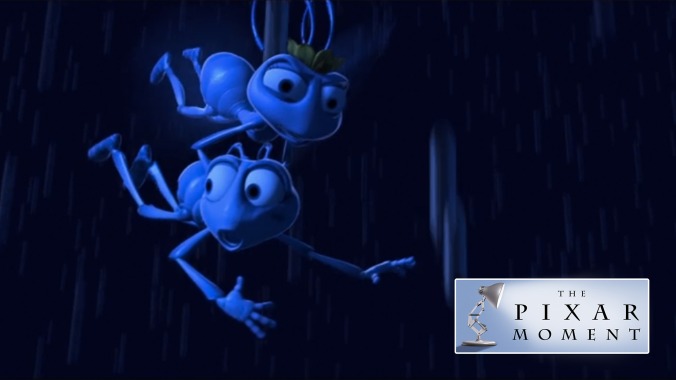A Bug’s Life is the technological marvel Pixar left behind

A Bug’s Life has become the Jan Brady of Pixar. Three years after Toy Story, the bar was set astronomically high for the company’s second feature-length outing with Disney—and while the film about the little ant that could raked in just $10 million less than its predecessor’s worldwide box office total of $373 million, it never seemed to step out of the shadow of its big brother. But to write the film off as a “sophomore slump” would be doing a disservice to the storytelling and pioneering digital animation of the Bug’s Life team.
The success of A Bug’s Life is most evident in the film’s climax, in which inventor ant Flick (Dave Foley) and Princess Atta (Julia Louis-Dreyfus) rally their colony to rise against the evil grasshopper gang led by Hopper (Kevin Spacey, unfortunately). Originally inspired by Aesop’s The Ant And The Grasshopper, the Pixar crew molded the simple fable into an epic that concurrently celebrates the powers of the individual and banding together. In many ways, the image of the colony locking their arms together as a united front against an oppressor is more relevant to U.S. audiences today than it was in 1998. And the revolt that ensues weaves together moments that progress multiple storylines in a way that most Disney animation hadn’t up until then.
Technologically, there were a lot of lessons learned and advances made during the creation of Toy Story that made the Bug’s Life team’s job easier. (Pixar actually chose bugs as the central figures because—like toys—they had hard and smooth exteriors, which were easier to render.) But there was still an impressive amount of innovation required to bring Flick and his cavalry of circus performers to life. John Lasseter (the director, unfortunately) was fascinated with the way sunlight shone through leaves, almost like a stained-glass ceiling. To replicate the effect, the Pixar animators implemented a technique called subsurface scattering for the first time. And animating a group of 800 ants was no easy task. The film features an end credit “blooper” in which Dr. Flora (Edie McClurg) accidentally knocks over a cardboard cutout she thinks is a real ant, but in reality the animators knew the insects would appear lifeless if they were ever still.
They also knew it wasn’t practical to design each ant individually, nor was it acceptable for the ants to move in unison. To solve the problem, a software was developed to take a cluster of ants, duplicate them, and then randomly place them into group scenes. The ants were then customized so no two appeared alike. And, yes, the large rain droplets in the climax look woefully archaic in 2020, but the wave of rain water careening around the corner and rushing along the gorge toward Ant Island remains one of Pixar’s most realistic effects. A Bug’s Life continued to be at the forefront of innovation even after release: In 1999, it became the first film to be digitally transferred frame-by-frame for DVD, retaining its original widescreen format.
Sandwiched in between the revered Toy Story and Toy Story 2, A Bug’s Life has been referred to as the “forgotten” Pixar film. It’s never touted on film posters, and it’s literally being erased from Disney’s California Adventure theme park to make room for Marvel experiences, one of its rides repurposed as an Inside Out ride and relocated to the newly opened Pixar Pier, which features no Bug’s Life attractions. It’s a sad fate for the film that solidified Pixar as more than a one-hit wonder. Once a treasured possession, A Bug’s Life has been cast aside for what’s shiny and new. There’s a certain cowboy doll who may know the feeling.